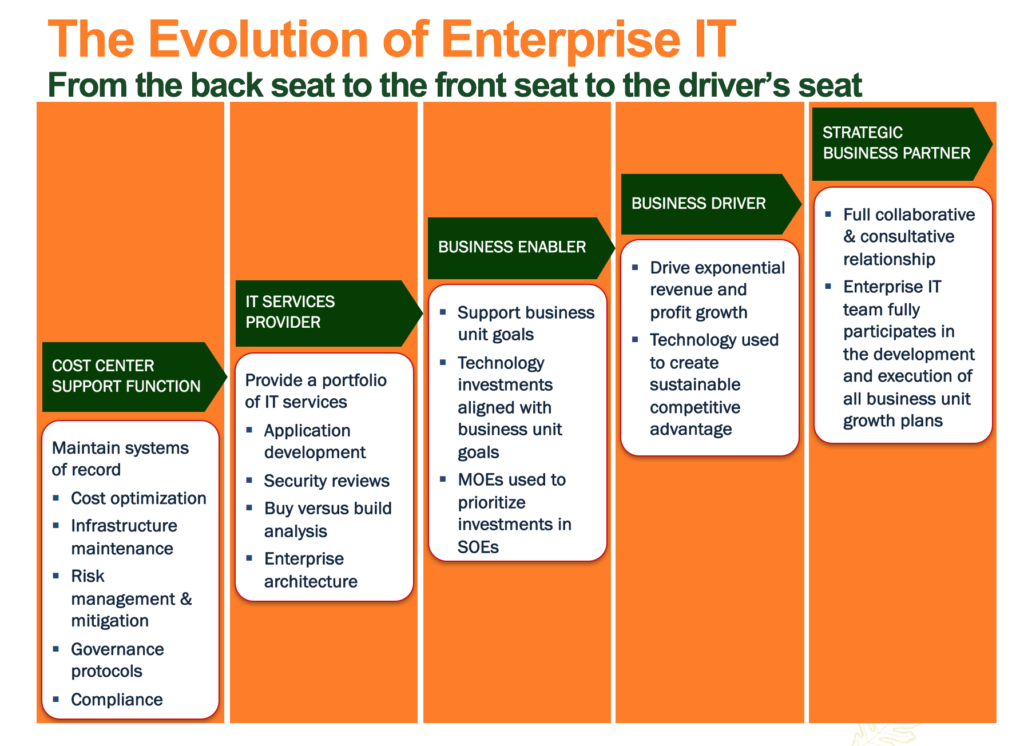In the New Digital World, Good Enough is No Longer Good Enough
Authored by: Peter D. Moore, Business Strategy Advisor
Speaker, April 10, 2018, CIO Peer Forum
“There’s never been a better time to be a great CIO or a worse time to be an average one.”
This quote from George Westerman, a leader of MIT’s Initiative on the Digital Economy, sends a clear message that good enough is no longer good enough. CIOs who still feel their primary job is to maintain the systems of record (SOR) that “run the business” are viewed as just average. While CIOs who develop and deploy systems of engagement (SOE) and systems of intelligence (SOI) that “change the business” are seen as making a critically essential contribution to the future competitive success of their organizations as digital enterprises.
To be perfectly clear this is not an either-or proposition but rather a both-and proposition. The key is to reverse the way IT resources are allocated.
What does average look like?
 Most IT budgets still allocate 80% of their resources to running the business and 20% to changing the business. The emerging reality is that every dollar invested in SOR-support systems and software produces a diluted return to the company in terms of competitive differentiation. The reason being that 95% of the lifetime value of these investments has already been received. As such, they no longer deliver competitive differentiation.
Most IT budgets still allocate 80% of their resources to running the business and 20% to changing the business. The emerging reality is that every dollar invested in SOR-support systems and software produces a diluted return to the company in terms of competitive differentiation. The reason being that 95% of the lifetime value of these investments has already been received. As such, they no longer deliver competitive differentiation.
By contrast, every dollar invested in SOE and SOI systems and software offer a much higher revenue and profit stream because they will be the primary source of future competitive advantage in the new digital era. To go from average to great you have to start by redeploying IT resources away from low value / low return activities to high value / high return activities.
What does great look like?
Historically IT has been viewed as a cost center support function whose primary responsibility is to build and maintain secure and stable platforms and tools  that “keep the lights on.” While it is still essential to securely maintain these systems of record, in the new digital era it is now a competitive imperative that IT evolves into a business enablement role that leverages digital technology innovations which deliver increased revenues, margins, and profits. Simply put, IT has to move from the back seat to the front seat to the driver’s seat.
that “keep the lights on.” While it is still essential to securely maintain these systems of record, in the new digital era it is now a competitive imperative that IT evolves into a business enablement role that leverages digital technology innovations which deliver increased revenues, margins, and profits. Simply put, IT has to move from the back seat to the front seat to the driver’s seat.
What are some CIOs doing to be great?
Ed McLaughlin, CIO at Mastercard, says “you really have to cease thinking of technology as a cost center. Technology is one of the primary assets of the business. So, you move away from thinking in terms of implementation projects, and more about how to run ongoing programs and get a feedback loop where you’re constantly optimizing those assets.” He and his leadership team are constantly asking two questions:
- How do you optimize new value creation?
- How do you optimize processes that make it easier to onboard customers and provide customer support?
Deanna Wise, CIO at Dignity Health, says “partnerships with the business, being innovative and seeing how you can drive a better customer experience does translate into revenue. There are a lot of forward-thinking CIOs who ask …what new programs and new initiatives can we use to drive revenue throughout the business?” According to Wise, “CIOs who fail to ask these questions do so at their peril. If IT is perceived as a cost in your organization and you do nothing to change that…you’ve made IT a commodity, and commodities can always be replaced.”
Jim Fowler, CIO at GE, thinks that if you want to turn enterprise technology into a source of monetary value and not just an expense, data is a great place to start. He says that monetary value “in the next ten years is going to come from connecting the value stream of information in a business, information about products, all the data coming off machines, and turning it into signals that will help automate work.”
Vijay Sankaran, CIO at TD Ameritrade, says that for him and his IT team “…design thinking is huge. It has become a critical tool in the pursuit of roboadvisers, chatbots and other customer-facing technologies intended to drive revenue growth.” Design thinking has helped Sankaran’s team visualize the client experience for applications they are building so they can fully understand their value along all the different customer touch points.
Wayne Shurts, CIO at Sysco, says “the burden is on the CIO to make the case that IT is concerned with more than cyber and risk management and it’s more than a cost center. The role of the CIO isn’t to go to the board to discuss every project. It’s to talk about how technology should operate across the organization and how investments support that.”
What can you do to assess where you stand today?
 A good starting point to assess where your IT team stands today is to conduct a trapped value audit. This audit starts by determining what percentage of your IT resources and budget are allocated to run the business functions in the left-hand column in the chart below versus change the business functions in the right-hand column. Once you’ve established your resource allocation baseline, you can then begin a systematic review of how you can redeploy resources and budget from the left-hand column to the right-hand column. I am currently working with a CIO and his senior leadership team who have made very measurable progress moving their resource allocations and budgets from 76% – 24% to 60% – 40% in just one year.
A good starting point to assess where your IT team stands today is to conduct a trapped value audit. This audit starts by determining what percentage of your IT resources and budget are allocated to run the business functions in the left-hand column in the chart below versus change the business functions in the right-hand column. Once you’ve established your resource allocation baseline, you can then begin a systematic review of how you can redeploy resources and budget from the left-hand column to the right-hand column. I am currently working with a CIO and his senior leadership team who have made very measurable progress moving their resource allocations and budgets from 76% – 24% to 60% – 40% in just one year.
What do you want the IT brand to stand for in your company?
As the examples above clearly illustrate, CIOs who aspire to be great have identified very specific ways to demonstrate the impact and value technology brings to their organizations. They have embraced this era of digital disruption as a new leadership challenge and an opportunity to redefine what the IT brand stands for in their companies, including:
- A higher percentage of IT resources allocated to change-the-business outcomes
- A significant improvement in time to value and throughput for all development initiatives
- A strong alignment between future technology investments and critical business outcomes
- A direct contributor to delivering increased revenues, margins and profits
- While each CIO’s journey from average to great may take different paths, it seems clear that they all start with the recognition that good enough is no longer good enough.
